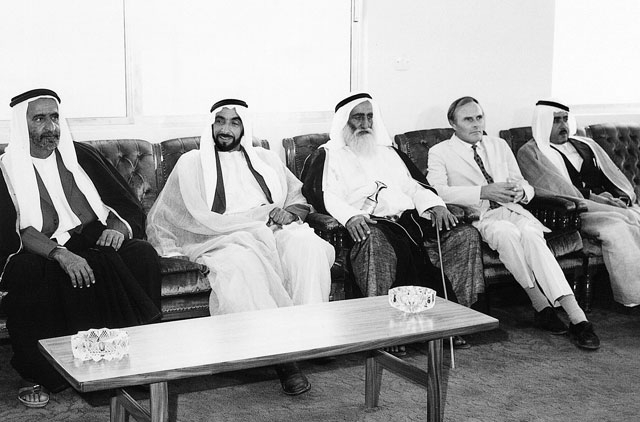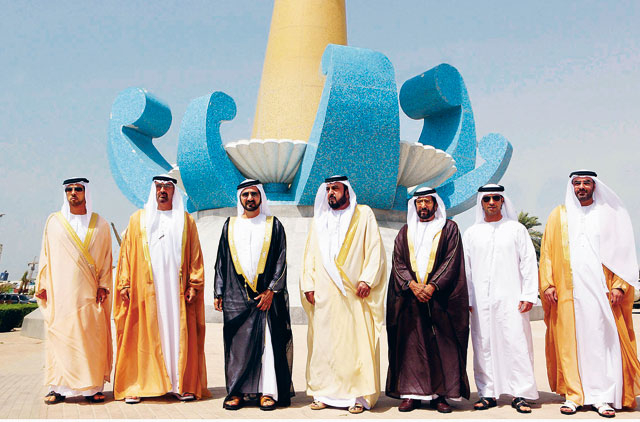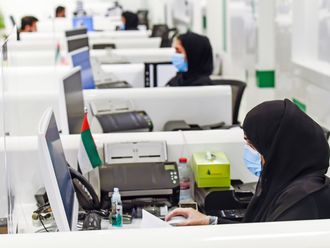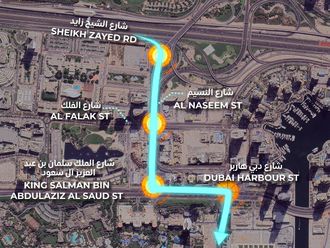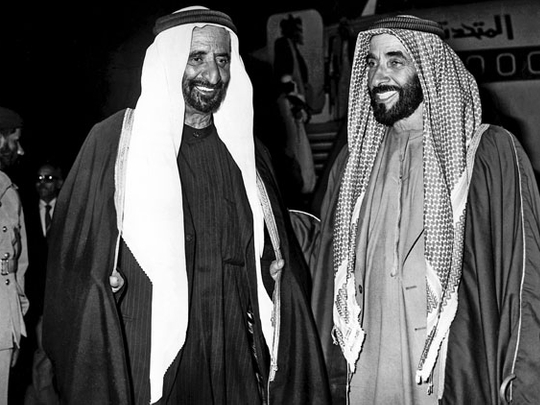
The story of the UAE is a remarkable tale of human determination to succeed against all odds. The modern and dynamic country we live in today is the result of more than 40 years of hard work by the leaders and the people of the UAE, and the shining success of this young country is a testament to their determination to make it work.
But this success was not automatic. The apparent ease with which the UAE works today is the result of dedicated work in overcoming both inter-emirate rivalries, as well as regional predators.
Until the signing of the UAE’s charter on December 2, 1971, it was not obvious that the idea would succeed. And some years after the UAE’s foundation, tensions between the emirates and their neighbours gave rise to continual doubts about the future of this fledgling state.
There were many problems. Firstly, the various emirates of the Gulf were all fiercely independent of each other, and had no tradition of pooling or sharing their sovereignty. Secondly, the British had been the hegemonic power since the 1830s, but suddenly decided to pull out leaving a potentially dangerous power vacuum. Harold Wilson’s government announced in 1967 that Britain would retreat from any engagement east of Suez and Ted Heath’s new Conservative government confirmed the policy when elected
in 1970.
Thirdly, just as the British were rushing to leave the Gulf, the new Arab socialist republics in Egypt, Iraq and Syria were speaking out against the British, and any monarchical Arab regimes which might be seen as their allies. They had just successfully backed the republicans in North Yemen against the former hereditary rulers during a brutal civil war that had lasted most of the 1960s. And fourthly, all sorts of outside forces were well aware of the emirates’ future oil wealth, and were keen to benefit from any possible political confusion. For example, the Shah’s Iran moved quickly to launch its specious claims on Bahrain and the three UAE islands of Abu Mousa, Greater Tunb and Lesser Tunb; and the Marxist-backed People’s Front for the Liberation of the Arab Gulf, sent its cadres up from communist South Yemen to foment rebellion in the Gulf.
Leadership needed
This maelstrom of regional and global tensions required very keen leadership and vision to see a successful way through the dangers, while at the same time managing the formidable task of knitting together the staunchly independent rulers and peoples of the many emirates into a single new nation state.
The success of the UAE owes everything to two men: the late Shaikh Zayed Bin Sultan Al Nahyan, the Ruler of Abu Dhabi since 1966, and the late Shaikh Rashid Bin Saeed Al Maktoum, the Ruler of Dubai since 1958. They were able to see beyond the difficulties and frustrations of their immediate surroundings in the late 1960s, and maintain their focus on their mutual long-term goal of building a prosperous and independent UAE.
Shaikh Zayed and Shaikh Rashid, along with the other members of the Supreme Council and many other leading officials, laboured hard all through the end of the 1960s through 1970 to make the concept of federation a reality. The initial plan for federation included nine emirates, and the rulers of Bahrain and Qatar were very much part of the initial talks in the late 1960s. Certain common practices indicated that merged statehood might be possible, such as all nine emirates sharing a common Gulf currency at the time.
In October 1970, the Deputy Rulers of the nine emirates met in Abu Dhabi, but failed to come to an agreement on the constitution for a federation of all nine, mainly due to a Bahraini demand for more popular representation in what they were calling the Union Council (the future Federal National Council). Talks continued all through the rest of 1970 and early 1971, the situation being made much more urgent by a statement from British Foreign Secretary Sir Alec Douglas-Home on March 1, 1971, when he made clear that British forces would leave the region by the end of 1971.
Seven emirates
This led to a busy round of talks during which Bahrain was clearly heading for its own statehood, and despite Dubai’s strong support for Qatar to remain in the future UAE, in July 1971 the rulers of the seven emirates met in Dubai as members of the Trucial States Council. They used the meeting to prepare for both the transfer of power from Britain, as well as the formation of the UAE as a federation of seven, as is told in the book From Trucial States to United Arab Emirates, by Frauke Heard-Bey. This July agreement was a major step in the development of the UAE, and was the basis of a framework under which the structure of a new government could be worked out during the rest of that summer and autumn on 1971. The future UAE of seven emirates lost a lot of skilled people when the more developed emirates of Bahrain and Qatar withdrew and took their educated labour force with them, but they needed to get on and forge their nation regardless.
Despite all the diplomacy, when the UAE was actually declared on December 2, 1971, Ras Al Khaimah was still uncertain about several aspects of the planned federation and did not to feel able to join, as it was looking for a better economic deal, but also for more representation in the Federal National Council. But by February 1972 those problems had been ironed out and the seventh and final emirate joined the UAE.
Internal challenges
The success of signing the UAE into existence was also the start of a whole new range of very difficult problems. The new country needed new nationwide institutions through which the new federal government would be able to exercise its authority, which would over-rule the long-established authority of each emirate government.
Having spoken for many years about the issue, the core challenge for the seven emirate governments was how to actually put into practice the merging of their previously independent powers. The new federal ministries took up their tasks and started to implement their UAE-wide structures. This inevitably caused tensions, which were exacerbated by it not being very clear who was to pay for the federal government.
The new country had three key federal bodies. The highest in authority was the Supreme Council, made up of the seven rulers who had both executive and legislative authority. The Cabinet was made up of all the ministers and it had the task of bringing the new government into coherent order. And the Federal National Council (FNC) was the representative chamber which included members from every emirate.
These FNC members were all appointed but their high degree of independence is shown by the way they reacted to the long-drawn- out crisis of the 1970s. Tensions grew between those who wanted a more centralised state with more powers going to the UAE federal government, and those who wanted a more developed state with the emirates retaining much of their authority.
By the mid-1970s, the difficulties became substantial and while Supreme Council Members continued to meet informally, the council did not hold a formal meeting after 1976 for three years. In order to close this gap, the Federal National Council and the Cabinet held a joint session in February 1979, which publicly criticised the Supreme Council for the first time over its performance, and also submitted a long and detailed memorandum calling for a substantial increase in centralised powers for the federal institutions, including the unification of all emirate armed forces, abandoning the emirate borders, and more federal control over the spending of oil wealth, according to From Trucial States to United Arab Emirates.
This radical document thoroughly alarmed the more federally minded emirates, led by Dubai, which prepared a counter memorandum seeking a more developed system of government while also being just as insistent as the other memorandum on the importance of unity within the federation.
The internal debates continued all through the spring of 1979, while outside events also required the leaders’ attention: Iran’s Islamic Revolution was in full swing; Zia Ul Haq, the new military ruler of Pakistan executed the former Prime Minister Bhutto; and the UAE was taking part in pan-Arab discussions about implementing sanctions on Egypt for making peace with Israel.
Nonetheless, the leadership of the UAE stayed focused on its own issues as well, and by July 1979 they had found the compromise that was to guide the nation into its long path of steady growth for many decades. The suggestions for radical centralisation were set aside, and many devolved aspects of authority remained, but Shaikh Rashid also joined a new cabinet of which he became prime minister, giving him new authority at the central level. By 1980, the leadership had also agreed on a formula for long-term funding for the federal government, based on emirates with natural resources putting in a proportion of their revenues.
Federation generation
This new stability allowed the UAE to focus on its key priorities, which were the economic development of the country and the education of its young people. The UAE was a very young country during the 1970s and 1980s, and made a point of looking inwards to its own development.
One such example was the way the government placed great importance on the UAE University, and not just for its educational qualities. As Shaikh Nahyan Bin Mubarak Al Nahyan, then Vice Chancellor of the university and later Minister of Higher Education and Scientific Research, explained in an interview in the mid-1980s, “We are developing the Federation generation. These young people are the first in the history of the emirates to grow up meeting young people of their own age from different emirates, different tribes, different families, and even different sexes. The friendships they make at university are an important part of binding the UAE together into one country.”
This kind of building a new society has been very important, because these new attitudes have sunk into Emirati society, and become part of the fabric of the nation. It is now very clear that all young people think of themselves as Emirati. They may also be from Dubai, Abu Dhabi or Ras Al Khaimah, but their prime identifier is their nation.
Many will cheer for their local football club, but they will also go mad with delight if the UAE wins the Gulf Cup, celebrating in cars decorated in the national colours, mustering in long processions which tour the UAE cities with wild exuberance.
Looking ahead
The founding fathers of the UAE have passed on, but their sons have taken up the role of leading the nation. They are working in a different environment from their fathers, and their problems are different, but there is a lot which is still the same: the government still has to work to inspire its young people. The entrepreneurs still need a legal environment in which they can prosper. People need a peaceful and stable environment in which they can develop their own ambitions.
The world may have changed in the past 40 years, but human beings are still the same with the same kind of minds and emotions. So the UAE is still wrestling with how to find the right balance between emirate and central authority, and how to distribute the wealth more evenly across the whole country. The problem of rural poverty remains an issue. It is still trying to improve its education and offer a better syllabus to government schools.
But a genuinely new problem is to reinforce the UAE’s national identity. With a national population of under 20 per cent of the total population of the country, it has become very important for all UAE nationals, and expatriates, to be consciously aware of the country’s history, language and culture. This was not an issue for the generation of the founding fathers, but is very important for the new generation lest something precious might be lost. This has triggered a powerful consensus across all strands of Emirati society that the UAE needs better teaching and more widespread use of Arabic, better education which encourages people to think for themselves, and some active social policies from the government to reinforce UAE national identity and encourage a more self-aware Emirati identity.
But despite the huge challenge of getting this delicate issue right, the successful experience of the past 40 years means that the UAE government and people both feel that they will succeed. They have a successful track record based on 40 years of hard work, which shows that they can build a nation in the harshest environment.


